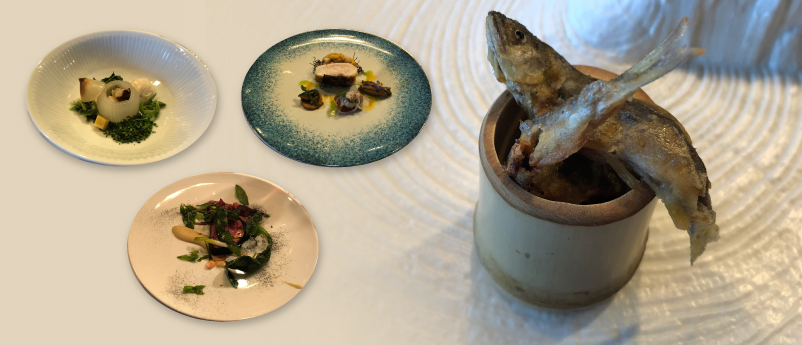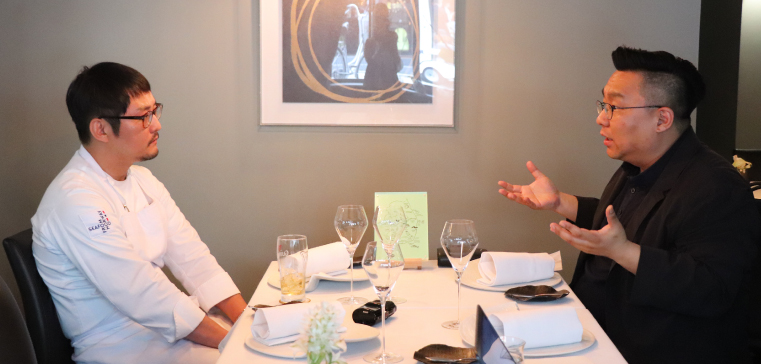For greater flavor, gourmets see more variety as the answer : Experts want Koreans to taste differences in regional produce

The restaurant Ryunique in Garosu-gil, southern Seoul, serves dishes that its executive chef Ryu Tae-hwan gets from his visits to regions across Korea. [LEE SUN-MIN]
Prof. Moon Jung-hoon of Seoul National University’s Regional Information program under the department of agricultural economics and rural development has strong opinions on Korea’s regional produce.
Garlic from Samcheok in the mountains of Gangwon has a subtle taste suitable for grilling, while garlic from Namhae County in South Gyeongsang, on the southern coast, has a stronger kick and spice, making it perfect for sauces, Moon said.
However, many home cooks lack understanding on how local ingredients can make their food taste even better. Moon argues that education should come from local restaurants, where chefs have more experience with different types of vegetables and animal products.
At many restaurants, chefs test out different vegetables from various regions and different farms and nearby markets before putting a dish out on the dining table for guests.
The characteristics of products from different regions are slowly being appreciated at restaurants in Seoul. Some hotels, like the Banyan Tree Club and Spa Seoul, have introduced dishes using diverse ingredients from all across the country and have chefs or servers explain why certain ingredients from certain areas are chosen. The idea has also been picked up by chefs at fine-dining style restaurants, as they have more contact with customers than other restaurants and take the time to explain what they are serving. Chef Ryu Tae-hwan of Ryunique in Sinsa-dong, southern Seoul, presents a printed map of the Korean Peninsula with the regions where he gets his ingredients from marked. Ryu is one of a number of chefs that are been hunting down the best farmers and fishermen from across the country.
Korean ingredients are now sought after by big-name culinary experts across the world, with many paying attention to using local beans for doenjang (soybean paste) and local peppers for gochujang (chili paste). Efforts to get different types of peppers and beans on to the local market haven’t been successful, though. Consumers generally look for low prices rather than quality.
Moon and Ryu sat down with the Korea JoongAng Daily to talk about how things can be changed.
They suggested that restaurants can allow people to experience different types of simple ingredients, while academics can do research with farmers to discover whether they can make a profit with more diverse types of crops.

Chef Ryu Tae-hwan of Ryunique and Prof. Moon Jung-hoon of Seoul National University talk about how to increase the variety of ingredients available in Korea. [TASTY KOREA]
A. Moon: What’s important is for farmers to also know more about what the gastronomic experience is. They need to see how the techniques and ideas used at restaurants can help bringing out the smallest details from what they grow. I took a pig farm owner in Korea to Spain and showed him how pigs are running outside there instead of being in a cage, and then I took him a gastronomic restaurant. If farmers get to have these experiences, it will contribute to them farming quality ingredients as well as restoring genes that have been not used, just because they are not produced in bulk.
Ryu: Onions, of course, are easily found at supermarkets. But one gets to see how all onions aren’t the same when they go meet farmers at their farms and see how they grow different varieties with different techniques. When I taste those onions or any other ingredients, ideas of where to focus on - whether to highlight the raw taste or to add more cooking techniques to add [flavor] - can be decided.
Why is it important to diversify the varieties of the same ingredients?
Moon: What happens when a certain species is prone to a particular disease or weak in certain climate change? We need to diversify the pool of genes instead of going only for the ones that brings the most economic effectiveness.
Ryu: [Having variety] contributes in making gamchilmat (widely known as the Japanese word umami) that’s hidden behind. There needs to be some supporting flavors to give food more structure. Chefs can make anything as long as there are ingredients. And we can start a sort of paradigm as we can try using things that are not preferred [in home kitchens at the moment], and make something tasty.
Why is it so difficult for consumers to know what types of ingredients are out there and how they are different from one region to another?
Moon: There is a system where we name certain potatoes or tomatoes after the region they are grown in. There is an attempt to categorize food ingredients meticulously, but consumers still aren’t familiar with the idea that there can be different types of potatoes. The concept of eating seasonal ingredients has always been around, but having those ingredients have the best performance possible has been [foreign].
Chefs at restaurants should get hands-on to make dining tables more fruitful so that diners can experience this food and also do the same at home. Farmers have been focusing more on mass production than trying out different varieties, because mass production brings them more profit. And so far, there hasn’t been such a niche market that wants different varieties. That’s why chefs at restaurants can be a solution to have consumers experience different flavors from what seems to be the same potatoes and garlic.
How about making what’s readily available overseas also available in Korea? Could that also be used to bring more ingredient diversity to Korea?
Ryu: Little things one can do are to plant them in smaller lots. We do it at the restaurant. In the first three years, there were some trial and errors, but I’m getting better in making the best use out of them. Now I’m testing out growing lemongrass. People will hardly see anything particularly different.
Moon: There are many foreign nationals in rural areas who moved to Korea through international marriage, and I have seen that they have started to plant [their own crops].
BY LEE SUN-MIN [summerlee@joongang.co.kr]










with the Korea JoongAng Daily
To write comments, please log in to one of the accounts.
Standards Board Policy (0/250자)